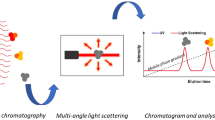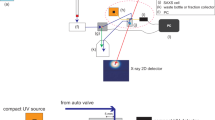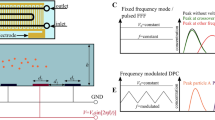Abstract
Size exclusion chromatography (SEC) with a multiangle light scattering (MALS) detector is widely used as standard molecular characterization equipment. The interdetector delay volume (IDV) between the MALS and differential refractometer (RI) detectors is an essential instrumental parameter that affects reliability and accuracy. However, a reliable and accurate determination method has not been established to date. This paper presents a method for determining the IDV value. SEC-MALS elution behavior has been thoroughly studied for polystyrene (PSt) standards with weight average molar mass (Mw) ranging from 1.02 × 104 to 109 × 104 g mol−1, ethylbenzene, and bovine serum albumin at different flow rates (U) ranging from 0.1 to 1.0 cm3 min−1 and at different particle sizes (dp) of the porous packing gels ranging from 5 to 30 μm. The apparent IDV values, IDVapp, estimated by superimposing the RI signal on the MALS signal, varied considerably with U, dp, and Mw because of band broadening and turbulence. The heights equivalent to a theoretical plate, H, were estimated for the MALS chromatogram (HMALS) and RI chromatogram (HRI), and they were rationalized as a function of U, Mw, and dp. The IDVapp functions HMALS and ΔH = HMALS − HRI corresponded to the band broadening occurring in SEC columns and the disturbance effects in the connecting tube between the MALS and RI detectors and in both cells, respectively. A reliable IDV was obtained when both the HMALS and ΔH values were minimized, i.e., U → 0 and Mw → 0. The IDV value determined at U = 0 and Mw = 0 was 24% lower than resulting from the currently recommended method. A SEC-MALS setup with the correct IDV value enables one to estimate more accurately not only the Mw and z-average root-mean-square radius of gyration but also the number average molar mass (Mn) and differential weight distribution function for PSts having narrow and broad molar mass distributions.
This is a preview of subscription content, access via your institution
Access options
Subscribe to this journal
Receive 12 print issues and online access
$259.00 per year
only $21.58 per issue
Buy this article
- Purchase on Springer Link
- Instant access to full article PDF
Prices may be subject to local taxes which are calculated during checkout













Similar content being viewed by others
References
Mori S, Barth HG. Size exclusion chromatography. New York : Springer; 1999.
Cooper AR, editor. Determination of molecular weight (chemical analysis: a series of monographs on analytical chemistry and its applications). New York: John Wiley & Sons Inc.; 1989.
Potschka M, Dubin PL, editors. Strategies in size exclusion chromatography, ACS symposium series. Washington DC: ACS; 1995.
Young CS, Dolan JW. Success with evaporative light-scattering detection. LCGC North Am. 2003;21:120–8.
Wyatt PJ. Light scattering and the absolute characterization of macromolecules. Anal Chim Acta. 1993;272:1–40.
Wintermantel M, Antonietti M, Schmidt M. Structure determination of polymers by size-exclusion chromatography equipped with multi-angle light scattering and viscosity detectors. J Appl Polym Sci. 1993;52:91–103.
Podzimek S. Light scattering, size exclusion chromatography and asymmetric flow field flow fractionation. New Jersey: John Wiley & Sons Inc.; 2011.
Podzimek S. Multi-angle light scattering: an efficient tool revealing molecular structure of synthetic polymers. Macromol Symp. 2019;384:1800174.
Netopilík M, Podzimek S, Kratochvíl P. Determination of the interdetector volume by s-detection in size-exclusion chromatography of polymers with on-line multiangle light-scattering detection. J Chromatogr A. 2004;1045:37–41.
Jackson C, Yau WW. Computer simulation study of size-exclusion chromatography with simultaneous viscometry and light scattering measurements. J Chromatogr A. 1993;645:209–17.
Clementi LA, Yossen MM, Vega JR. Molar mass distributions of linear homopolymers by size exclusion chromatography with light scattering detection: a method for automatic band broadening correction. J Chromatogr A. 2019;1595:136–43.
Thitiratsakul R, Balke ST, Mourey TH. Combining detectors in size exclusion chromatography: I. Interdetector volume. Int J Polym Anal Charact. 1996;2:345–57.
Mourey TH, Miller SM. Measurement of interdetector volume in size exclusion/low-angle laser light scattering experiments. J Liq Chromatogr. 1990;13:693–702.
Grinias J, Bunner B, Gilar M, Jorgenson JW. Measurement and modeling of extra-column effects due to injection and connections in capillary liquid chromatography. Chromatography. 2015;2:669–90.
Fekete S, Fekete J. The impact of extra-column band broadening on the chromatographic efficiency of 5 cm long narrow-bore very efficient columns. J Chromatogr A. 2011;1218:5286–91.
Goyon A, Guillarme D, Fekete S. The importance of system band broadening in modern size exclusion chromatography. J Pharm Biomed Anal. 2017;135:50–60.
Fountain KJ, Neue UD, Grumbach ES, Diehl DM. Effects of extra-column band spreading, liquid chromatography system operating pressure, and column temperature on the performance of sub-2-μm porous particles. J Chromatogr A. 2009;1216:5979–88.
Lucy CA, Glavina LLM, Cantwell FF. A laboratory experiment on extracolumn band broadening in liquid chromatography. J Chem Educ. 1995;72:367–74.
Popovici ST, Kok WT, Schoenmakers PJ. Band broadening in size-exclusion chromatography of polydisperse samples. J Chromatogr A. 2004;1060:237–52.
van Deemter JJ, Zuiderweg FJ, Klinkenberg A. Longitudinal diffusion and resistance to mass transfer as causes of nonideality in chromatography. Chem Eng Sci. 1956;5:271–89.
Aris R. On the dispersion of a solute in a fluid flowing through a tube. Proc R Soc Lond Ser. 1965;A235:67–77.
Taylor G. Dispersion of soluble matter in solvent flowing slowly through a tube. Proc R Soc Lond ser. 1953;A219:186–203.
Kondo Y, Nakamura Y. Comparison of molecular weight distribution determined from the three methods, SEC-calibration curve, SEC-MALS, and MALDI-TOF-MS measurements. Kobunshi Ronbunshu. 2018;75:367–70.
Busnel JP, Foucault F, Denis L, Lee W, Chang T. Investigation and interpretation of band broadening in size exclusion chromatography. J Chromatogr A. 2001;930:61–71.
Konkolewicz D, Taylor JWII, Castignolles P, Gray-Weale A, Gilbert RG. Toward a more general solution to the band-broadening problem in size separation of polymers. Macromolecules. 2007;40:3477–87.
Yossen MM, Vega JR, Meira GR. Estimation of band broadening in size-exclusion chromatography. I. A method based on analyzing narrow standards with a molar mass-sensitive detector. J Chromatogr A. 2006;1128:171–80.
Lee W, Lee H, Cha J, Chang T, Hanley KJ, Lodge TP. Molecular weight distribution of polystyrene made by anionic polymerization. Macromolecules. 2000;33:5111–5.
Flory PJ. Molecular size distribution in ethylene oxide polymers. J Am Chem Soc. 1940;62:1561–5.
Reed WF. Data evaluation for unified multi-detector size exclusion chromatography—molar Mass, viscosity and radius of gyration distributions. Macromol Chem Phys. 1995;196:1539–75.
Acknowledgements
The authors thank AJE (www.aje.com) for English language editing.
Author information
Authors and Affiliations
Contributions
The manuscript was written with contributions from all authors. All authors have approved the final version of the manuscript.
Corresponding authors
Ethics declarations
Conflict of interest
The authors declare no competing interests.
Additional information
Publisher’s note Springer Nature remains neutral with regard to jurisdictional claims in published maps and institutional affiliations.
Supplementary information
Rights and permissions
Springer Nature or its licensor (e.g. a society or other partner) holds exclusive rights to this article under a publishing agreement with the author(s) or other rightsholder(s); author self-archiving of the accepted manuscript version of this article is solely governed by the terms of such publishing agreement and applicable law.
About this article
Cite this article
Matsumoto, Y., Kikuchi, M., Ueda, K. et al. Highly reliable determination of the interdetector delay volume in SEC-MALS for precise characterization of macromolecules having narrow and broad molar mass distributions. Polym J 55, 239–251 (2023). https://doi.org/10.1038/s41428-022-00744-7
Received:
Revised:
Accepted:
Published:
Issue Date:
DOI: https://doi.org/10.1038/s41428-022-00744-7



